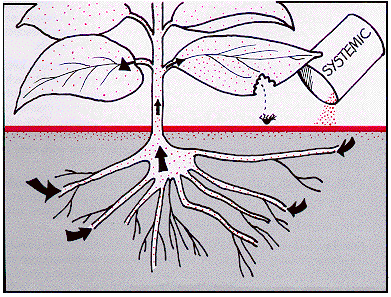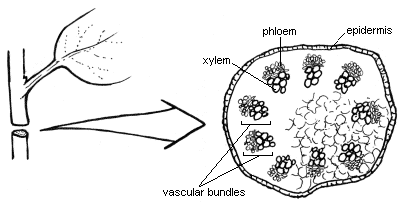
The Application of Metabolic Pathways on Biotechnology
Insecticides

What are Insecticides?
Insecticides can be defined as a fatal agent of biological or chemical origin desgined to control the destructive behavior of insects. This is accomplished by poisoning the nervous systems of insects with a lethal amount of dosage - enough to interfere with the neural pathways responsible for motor control, leading to problems such as tremors, incoordination, dizziness, nausea, and repsiratory problems. [1] [2] [3]
Image Citation

Interesting Fact
Did you know that the reason why insecticides often cause problems for organisms other than insects, is because insects, animals, and humans share a common nervous system?
The Nervous System: Insect Edition
Before going through the specific insecticides and seeing individually how they work, let's briefly see how the nervous system of and insect is actually designed.



How Do Insecticides Work?
There are three major methods to classify insecticides:
-
Systemic vs. Contact
-
Type of Compound
-
Mechanism of Action
Systemic vs. Contact
Systemic insecticides refer to a type of chemically created pesticide that is soluble enough in water to be absorbed into the cell structure of the plant, and move around in its tissues. It is important to note that these types of insecticides are actually within the plant structure, rather than located on the external surface.

The movement of these insecticides occurs within the plant’s vascular system through the phloem and xylem. This fatal circulation of chemicals within the plant’s tissues will effectively kill the insects that feed on them. [4] [5] [6]

Contact insecticides refer to a type of chemically created pesticide that come into direct contact with the insect. These insecticides infect the insects by entering through their skin or respiratory system. Unlike systemic insecticides, they are not soluble enough in water to be absorbed into the cell structure of a plant. Thus, when a contact insecticide is applied to a plant, it acts as a form of residue. And when the insect lands on the plant, the residue is absorbed by their feet which then enters the blood stream and damages the nervous system. [6] [7]
Type of Compound
By classifying insecticides by compound, there are three categories: inorganic, organic, and naturally-occuring. [6]
-
Inorganic insecticides come across as the oldest type of pesticide. These compounds consisted of metals referred to as "heavy" - these included arsenic, copper, fluorine, and sulfur.
-
Organic compounds are the most reknowned ones, having been manufactured during the 40s. These compounds are created with Carbon molecules.
-
And the last type, are the naturally-occuring insecticides. These, hence their name, are all natural - made from various flowers such as nicotine and pyrethrum.
Mechanism of Action
Organochlorines: These insecticides are manufactured from the compounds Carbon, Hydrogen, and Chlorine. They work by interfering the processing of the channels within the neuron. When Organochlorines are utilized, the sodium ion channel within the nerve cell is opened, causing them to spontaneously fire so rapidly that the insect will begin to experience spasms and eventually die. [2] [6]


Interesting Fact
Did you know that the most famous and one of the most destructive Organochlorines is DDT?
Organophosphates:This group of insecticides are created with Phosphorus as their primary base with six other compounds attached: Carbon, Oxygen, Sulfur, and Nitrogen. This insecticides also works by damaging the nervous system of an insect, but rather than interfering with the channels of each individual nerve cell, Organophosphates disrupt the process of these nerve cells communicating with each other.
In a typical nerve cell, an electrical impulse is taken in through the dendrites, and after a series of changes within the neuron’s charge, the impulse if fired down the axon of the cell, where it is required to jump the synapse to reach another nerve cell. A chemical referred to as Acetycholine (Ach) binds with the new cell and sends the incoming impulse down the new cell.


However, when an Organophosphate insecticide is utilized, the enzyme, Cholinesterase (ChE) is inhibited by binding with the Phosphorus base of the insecticide. As a result, ACh becomes accumulated within the neuron and muscle synapse causing rapid twitching of the voluntary muscles. This will eventually lead to paralysis and cause the insect to die.
Carbamates: Created from carbamic acid, Carbamates tend to bear similar tendencies and characteristics like those of Organophosphates, and like them, work by inhibiting the enzyme Cholinesterase (ChE). However, though their characteristics are similar, Carbamates are slightly different. Unlike Organophosphates, the inhibition of Cholinesterase is reversible and also selective against the ChE of varied species.

Pyrethroids: This type of insecticide was created to mimic the insect-destroying action of the chemicals within the Chrysanthemum flower. Similar to the properties of the DDT (a type of Organochlorine insecticide), Pyrethroids function by keeping the sodium ion channels within the neuron open, causing spontaneous firing of electrical impulses. This overstimulation will cause the insect to go through rapid spasms, and then death.


Nicotinoids: This type of insecticide is the synthetic version of nicotine. Natural nicotine typically functions by mimicking acetylcholine as a neurotransmitter, thus affecting the nerves related to motor coordination. Nicotinoids work within the central nervous system by permanently binding to the post-synaptic nicotinic acetylcholine receptors, which keeps the sodium ion channels of the neuron open and constantly allows these sodium ions to enter. This opening creates overstimulation of neural activity which causes insects to become jumpy and experience twitching, convulsions, disoriented movement, paralysis, and eventually death.

Though this illustration depicts the combined action of Imidacloprid (a type of nicotinoid) and Permethrin (a type of pyrethroid), it is important to note the role the nicotinoid plays within the neurons' synaptic gap.
The Imidacloprid binds itself at the Nicotinic receptors, causing these receptors to remain open permanently (allowing excess sodium ions to enter), rather than open and close (selectively allowing a smallamount of sodiym to enter). This permanent opening causes an amplified sense of stimulation in motor coordination.

Interesting Fact
Did you know that Pyrethroids affect not only the Central Nervous System, but the Peripheral Nervous System as well?
*Most insecticides affect only the Central Nervous Systerm.

Did you know that Nictoinoids are one of the main insecticides responsible for the collapses of many honeybee colonies?
Interesting Fact
Image Citation
The systemic application of insecticides. (above)
Image Citation
The vascular system of a plant. This diagram includes the major pathways (xylem and phloem) through which the chemicals travel. (Right)
Image Citation
The chemical structure of the compound DDT.
Image Citation
A diagram depicting how Acetylcholine typically functions. (Above)
An illustration of how Organophosphate inhibits Cholinesterase within the neuron. (Left)
Image Citation
Image Citation
Want to see how Organophosphate actually works? Watch the animation to find out how ChE is inhibited!
Want to see how Carbamates actually work? Watch the animation to find out how ChE is inhibited!
The chemical structure for an insecticide containing carbamic acid.
Image Citation